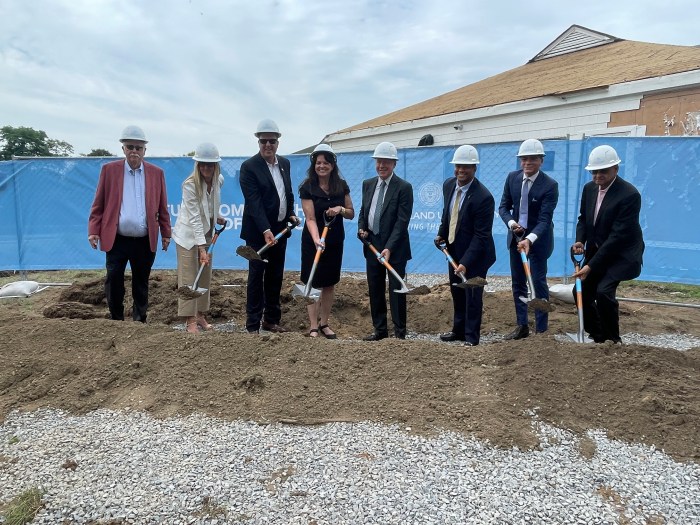The Friends of the Bay meeting to introduce the Watershed Action Plan for the Oyster Bay/Cold Spring Harbor watershed and estuary was presented to a full-house at the Oyster Bay High School Library on Oct. 12. Erik Mas and Dan Buttrick consultants from Fuss & O’Neill led the meeting after being introduced by FOB Executive Director Patricia Aitken.
In a way, if you know the players – the people who attended the meeting – you will have an idea of the scope of the interest in the work. Attending were: Jane Greenleaf there as a representative of the Mill Neck Village board; Tom Zoller, mayor of Cove Neck; (unfortunately the re-scheduled event was the same night of the Village Officials Association meeting which many local mayors attend); Dave Relyea of Frank M. Flower & Sons, Inc.; Walter Imperatore of Renaissance Properties; Mitch Kramer of TowBoat US; Sagamore Hill National Historic Site Superintendent Thomas Ross; waterfront activist Caroline DuBois; Matt Meng, East Norwich Civic Association President and an FOB board member; Barry Lamb, FOB president; Larry Weiss of the Oyster Bay Power Squadron; Jennifer Sappell, Long Island North Shore Heritage Area executive director; John Fischer of Trout Unlimited; Tom Hornosky of the North Shore Wildlife Sanctuary; Randy Jones of the Cold Spring Harbor Laboratory; Don Niddre of the Eagle Dock Foundation of CSH; Hal Johnson, microbiologist; and a very strong showing of FOB water quality monitoring volunteers as well as other interested people.
Historical Perspective
One of those attending was Oyster Bay Historical Society Executive Director Phil Blocklyn who took a historical perspective on the watershed issues in a telephone interview. He said, “I was writing things down recently about traditional uses of Oyster Bay’s waterfront and I found that it was very varied; and that Oyster Bay’s waterfront and the waters leading into it were used in many ways including generating electric power; for milling grain, there was a grist mill; and the water was used to power a sawmill, possibly; and there were pirates.
“There were sawmills that used either water or steam: the Titus sawmill, and at the Sammis lumber yard. There were freight and passenger steamers that came into Oyster Bay. There was a canal built where the Oyster Bay marina is now. The ground that is now TR park was the village dump; there were orchards in the watershed area.”
Warming up to the stories, he said, “There was a barber shop on stilts or pilings that was on White’s Creek, and next to it was the Columbia Hotel.
“Peter Layton’s boat shop was there. There was a flood when the mill dam broke and flooded all the land below it. That was a terrible thing. And there was a brick yard in Centre Island, right by the water and very visible from Oyster Bay – you could see it above the trees.
“The watershed has had a lot of varied and traditional uses over the years and when you look at it you can see which were industrial and which were aquaculture; which industries may have been more individual.
“There were always shellfishers working independently along the shore – not just oyster companies. There was the Oyster Bay Oyster Company- which was the Bayles company; then the Flower company; and then there were some companies from across the Sound that came here. One from South Norwalk, Connecticut that came here to fish, was Radel Oyster Company: and there was also Albert James Hoyt from South Norwalk who did some oystering here as well.
“So I would say – so much has been going on here for a long time – so it’s not just oysters and Roosevelt, a whole bunch of stuff has been going on,” he concluded.
Although he didn’t precisely mention it – there have been tall ships coming to Oyster Bay since the very first notice of the little port by Henry Hudson. George Washington commented on the fine sand here on the beaches. Before the arrival of the colonists from Europe over 350 years ago, this was an area used by the Matinecock Indians.
Cardstorming
The presenters at the meeting included former FOB executive director Louise Harrison who is now with the EPA. She brought a copy of a similar plan created for the Nissequogue River watershed that could be used as a model for the Oyster Bay/Cold Spring Harbor Watershed plan.
The presenters gave out note cards to the attendees for what is called a cardstorming exercise. The attendees filled out four cards suggesting what was most important to them in regard to the watershed. Eric Mas, PE with Fuss & O’Neill, Inc. put up the cards in groups on a large board. Then Mr. Mas asked the people to give names to the different groups of issues. That information will be the basis of the study.
The issue groups included: Harbor Usage which encompassed the items: pollution from boats; and over-congested mooring areas in Cold Spring Harbor.
At Risk Sites or Threats included: the former Nassau County culvert pipe in Bayville.
Coexisting Compatible Uses covered: high density living while setting aside open space; watch and slow development; jet skis in wetland areas; irresponsible residential development; public areas for access to estuary; encourage water dependent use of TR Park with row boats, swim lessons, fishing; and respectable co-existence.
Education Enforcement uses included: code enforcement; community awareness of pollutants; Route 106 runoff; more disposal areas for chemicals.
Fecal Matter/Pathogens mentioned: goose poop, human DNA in the water; poorly maintained septic systems; fecal contamination of Mill Neck Creek.
Habitat included: White’s Creek access and daylighting; invasive species; fish passage and or dam removal; habitat preservation and restoration; keep oysters in Oyster Bay; and protection of the eco-system.
Harbor Uses mentioned: pollution from boats; over congested mooring areas at Cold Spring Harbor.
Land Use regulations suggested comprehensive jurisdiction for proper management.
Plan Needs/Elements were: they need a mission statement and to secure funding.
Stormwater Management included: SPEDES Permits; plastic bottles – everything is not biodegradable; alternative designs for water run-off; targeted stormwater treatment; and water run-off management.
As the forum concluded Mr. Mas asked people to consider what areas they were most concerned about. Mr. Relyea said Mill Neck Creek; another person said the Mill Pond Creek area.
Mr. Relyea said he was “pleased that the evening turned out to be a focus group format, something the community has not experienced of late.” The process takes suggestions for the community at large which amazingly identifies issues that everyone appears to have on their mind.
“This is a good community project,” said Larry Weiss of the Oyster Bay Power Squadron.
Phil Blocklyn said, “I hope that people who didn’t attend will complete the watershed survey that’s on the Friends of the Bay web site.”
For more information please contact FOB at 922-6666 or by email at p.aitken@friendsofthebay.org. Please place “Steering Committee” in the subject line of the email.
The next Watershed Action Plan public meeting will be held on Wednesday, Dec. 1. The plan will include goals and action items that could be adopted by governmental agencies and private groups to protect and improve the health of the Oyster Bay/Cold Spring Harbor watershed and estuary.
All are welcome to attend. It will again be held in the Oyster Bay High School Library, 7 p.m. For more information, call 922-6666.


































